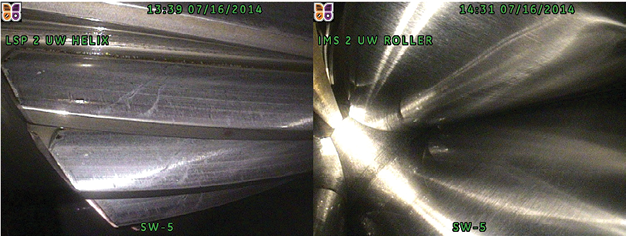Jesse H. Graeter / Lead Mechanical Engineer/Romax Technology Ltd /www.romaxtech.com
After a condition-monitoring system and analyst provide the diagnosis of an ailing gearbox, a technician has to confirm the problem, often with a borescope inspection. A visual account of the gears and bearings is one of the best ways to establish the health of a gearbox. A photo of a damaged component provides tangible evidence of a suspected condition. The challenge, as many know, lies in physically performing an effective inspection and appropriately documenting the findings.
In situ inspection uptower of a wind-turbine gearbox requires safe practices for both operator and machine. A health and safety review should establish proper procedures. The rotational energy must be locked out to protect the operator from pinch points and to prevent the borescope from crushing hazards. Note: Crushing a video-scope-camera head can cost $8,000 or more to repair.
There are many borescopes available on the market and the features on some help inspect MW class wind-turbine gearboxes. Interchangeable camera tips are mandatory for inspecting components at a distance and close up. For viewing ring gears, a high-light output and an infinite focal distance are needed to assess the condition of the entire tooth width over multiple teeth. Bearing inspections require a focal distance of 0.2 to 5.0 in. Damage such as axial cracks are detectable by using a near-focus tip and moving the reflecting light back and forth across the linear feature. Make sure it’s clear from the image that it is a crack, not just “some mark.”

The examples of quality borescope images show components properly labelled. LSP, for instance, identifies the low-speed helical planet gear.
The choice of borescope diameter is often a difficult decision. Gears are best inspected with a 6 mm or 8-mm borescope with exceptional light and clarity. Planet bearings are best accessed with 4-mm borescopes because of their small size and flexible head articulation. These trade-offs can be balanced with a 5-mm borescope.
Most often, gearbox inspections are conducted at a rate of two per day – when a fairly standard job is required. Scheduling one per day provides a more thorough drivetrain inspection, or where detailed evidence gathering is the focus, as in failure investigations or warranty claims.
For asset managers, make sure you are ordering the job you want, in-depth or quantity. For instance, the inspection of all planetary gears and bearings requires turning the rotor and gearbox two or three times. With experience and training the inspector learns how to find all the gears and bearings. A 3-ft length of guide tubing is extremely helpful. The plastic-coated aluminium holds its shape when bent, letting the borescope camera pass through the guide tube and arrive at a component of interest. Sun gears are inspected using guide tubing with a 90° bend so the borescope drapes over a planet gear to the center of the gearbox.
Work in the nacelle is half the job. Inspection photos are only useful when properly documented. A detailed checklist should be completed uptower during the inspection to note the condition of each component. A common documentation method is to take a photo of a component’s name-label before capturing a picture of that component. Then sort the images into appropriately named folders. Borescopes allow placing text directly on their images. This is a good practice to prevent confusion. A big time saver is to use programs written for the borescope to automatically label the images and name the files. Then have the report automatically generated from the inspection photos, saving hours of tedious computer work.
Remember, a gearbox inspector is more than a photographer. The philosophy is to perform a real-time inspection and then capture the images that support the findings. The inspector must be proficient in gearbox construction, failure modes, and technical-report writing. Most importantly, have a steady hand and lots of patience.
Training is also important, both on technique, failure modes, and for the common problems for various major models of gearboxes. Good training is available to the industry – onsite or offsite. Inspection images are often required to support warranty claims. Avoid the situation of denial “that’s not a crack, it’s a hair,” or “that’s not a pit, it’s an oil bead” by taking multiple images from different angles. On the other hand, avoid wasting time when it is just an oil bead, a hair, or minor damage. Close ups make damage look bigger than it is. Where possible combine a vibration diagnosis with inspection reports for a more supportable claim. WPE&D
Filed Under: News, O&M





